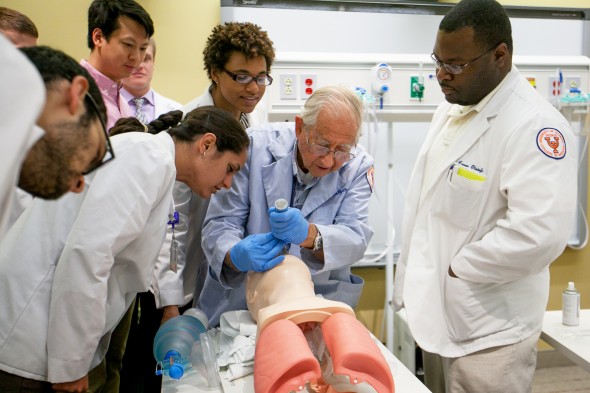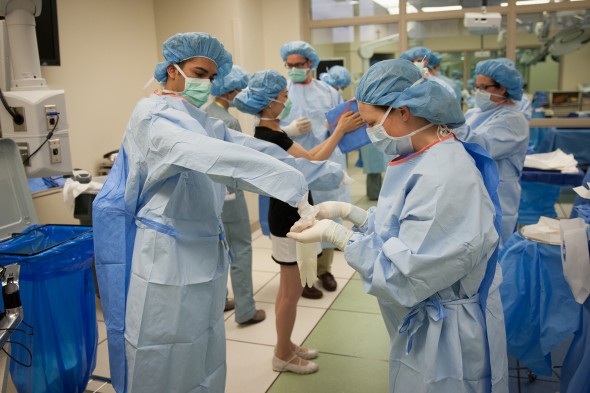Leap, skip and a Jump in medical education

The Jump Trading Simulation & Education Center develops new medical teaching devices, improves medical training methods and provides new ways for students to learn. The second floor is a virtual hospital with six patient rooms, two intensive care units and an operating room – all with real equipment.
Since the Jump Trading Simulation & Education Center opened its doors in downtown Peoria less than two years ago, the state-of-the-art medical training facility has provided 553,000 hours of learning to more than 52,000 people.
In that same timeframe, Jump — as it’s dubbed for short — has developed and patented new medical teaching devices, conducted research to improve medical training methods and fostered new ways for student learning. Whether you’re a medical or nursing student, a teacher directly involved with medical education and health care training, or your only experience with medicine is being a patient — it’s a place to marvel.
“We are far exceeding our expectations,” says John Vozenilek, Jump’s chief medical officer and the Duane and Mary Cullinan professor in simulation outcomes for the College of Medicine at Peoria. “The number of learners and the level of education, the grants and collaboration taking place, the innovation — we already are seeing benefits as it relates to patient impact as well as financial benefits by offsetting hospital expenses.”
The $51 million facility is a collaboration between the College of Medicine at Peoria and OSF HealthCare, one of the college’s primary affiliates. In terms of size, Jump is among the top five in the nation. In terms of scope, it is among the top three, says Vozenilek, who visited similar centers around the country and world as Jump was being designed.

An intern boot camp gives fourth-year medical students a chance to go on
simulated rounds to get a preview of what their residency experience.
The second floor at Jump is a virtual hospital with six patient rooms, two intensive care units and an operating room. All the medical equipment is real. All the disposable supplies are real.
Need to make a call from an inpatient room to the nursing station? Pick up the receiver – it works. Need medical grade air or oxygen? Turn the valve on the wall — it’s the real deal. The anesthesia machine in the operating room — it’s real, too.
And the medical simulation training at Jump involves actors trained as patients or high-tech manikins, many of which can simulate crying, sweating, breathing and blinking, some with pupils that dilate.
Taking advantage of this virtual hospital, College of Medicine faculty last year piloted a new “intern boot camp” for fourth-year medical students before they headed to residency. Students went on simulated rounds through the patient unit, responded to emergencies in the ICU and discharged patients without breaks between to simulate “a day in the life” of what they will experience as a resident working in the hospital.
“Because of the boot camp’s success, the course has been approved by the UIC faculty senate to become a required two-week experience for all UICOMP graduating seniors,” said Gerald Wickham, assistant dean for medical education and evaluation.
But the simulation center is more than just a virtual hospital. The first floor of Jump holds an anatomical skills lab for use with human and animal tissue; a transport center with an ambulance and fully-furnished apartment for paramedic and home health care training; and a innovations lab, where physicians can work with engineers to design, improve and build medical and training devices.
Cameras throughout the building record training for educational purposes, providing the ability to teach medical procedural skills at a distance, whether in a rural Midwestern hospital or in a clinic around the world.
“Jump has already proved itself as an enormous asset to our students, residents, faculty — and really the community at large,” said Sara Rusch, regional dean for the Peoria campus. “Visitors are amazed at what’s taking place here and what’s planned ahead — and just to see it is a great tool for recruiting.”
Advanced Medical Transport, a primary emergency and scheduled ambulance service provider to residents and communities throughout central Illinois, is partnering with Jump to provide paramedic pre-hospital care simulation training. A pilot project with Intel-GE Care Innovations is partnering with Jump to look at the connection between patient data from the home with data collected in clinical settings.
The college’s Center for Outcomes Research just finalized a report showing simulation education saved the hospital an estimated $1.5 million in the first year by improving efficient education and lowering complications related to a particular procedure.
“We’re doing a lot and we will continue to do more,” said Vozenilek. “We’re lowering health care costs through innovations, providing solutions for population health management, making available a pathway to clinical space for designers and builders of medical devices and technology, and moreover improving the education for tomorrow’s physicians and health care providers, which in turn improves health outcomes for patients.”
